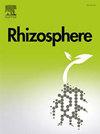Inoculation of wild type or EPS mutant Bacillus subtilis does not alter rhizocompetence, soil EPS, and tomato growth in the absence of stress
IF 3.4
3区 生物学
Q1 PLANT SCIENCES
引用次数: 0
Abstract
Biofilm formation on plant roots is traditionally assumed an important trait for plant growth promoting rhizobacteria, but its importance in the interplay between soil, plant roots and the rhizosphere bacterial and archaeal community is not well understood. In a greenhouse experiment, tomato plants grown in a sandy soil were inoculated with Bacillus subtilis NCIB 3610 wild type or a ΔepsA-O mutant strain with defective biofilm formation. Strain-dependent effects on rhizocompetence, bacterial/archaeal community composition, soil EPS contents and plant growth were hypothesized. High-throughput sequencing of 16S rRNA genes amplified from community DNA showed that inoculation-dependent shifts of the bacterial and archaeal community compositions occurred mainly in the rhizoplane and rhizosphere between one or eight days after inoculation. Contrary to our hypothesis, the mutant had a similar rhizocompetence as the wild type according to selective plating. The EPS-saccharide content in the soil and rhizosphere did not differ among inoculation treatments. Plants inoculated with the mutant had larger roots compared to the wild type and control treatments – likely due to inoculation-dependent bacterial and archaeal community shifts. Thus, this study shows that the inoculants′ ability to produce biofilms was not linked with rhizocompetence, EPS contents in soil and plant growth. It sheds light on new aspects regarding the relevance of biofilm formation for rhizocompetence and plant growth promotion under optimal plant growth conditions.
在没有胁迫的情况下,接种野生型或EPS突变型枯草芽孢杆菌不会改变根的能力、土壤EPS和番茄的生长
植物根系生物膜的形成历来被认为是促进植物生长的重要性状,但其在土壤、植物根系和根际细菌和古细菌群落之间相互作用中的重要性尚不清楚。在温室试验中,将生长在沙质土壤中的番茄植株接种枯草芽孢杆菌NCIB 3610野生型或生物膜形成缺陷的ΔepsA-O突变菌株。假设菌株对根竞争力、细菌/古细菌群落组成、土壤EPS含量和植物生长的影响。从菌落DNA中扩增的16S rRNA基因的高通量测序结果表明,在接种后1 ~ 8天,细菌和古菌群落组成的接种依赖变化主要发生在根际和根际。与我们的假设相反,根据选择性电镀,突变体具有与野生型相似的根竞争力。不同接种处理土壤和根际中eps -糖类含量无显著差异。与野生型和对照处理相比,接种了突变体的植株的根更大,这可能是由于接种依赖的细菌和古细菌群落的变化。因此,本研究表明,接种剂产生生物膜的能力与根竞争力、土壤中EPS含量和植物生长无关。它揭示了在最佳植物生长条件下,生物膜形成与根竞争力和植物生长促进的相关性的新方面。
本文章由计算机程序翻译,如有差异,请以英文原文为准。
求助全文
约1分钟内获得全文
求助全文
来源期刊

Rhizosphere
Agricultural and Biological Sciences-Agronomy and Crop Science
CiteScore
5.70
自引率
8.10%
发文量
155
审稿时长
29 days
期刊介绍:
Rhizosphere aims to advance the frontier of our understanding of plant-soil interactions. Rhizosphere is a multidisciplinary journal that publishes research on the interactions between plant roots, soil organisms, nutrients, and water. Except carbon fixation by photosynthesis, plants obtain all other elements primarily from soil through roots.
We are beginning to understand how communications at the rhizosphere, with soil organisms and other plant species, affect root exudates and nutrient uptake. This rapidly evolving subject utilizes molecular biology and genomic tools, food web or community structure manipulations, high performance liquid chromatography, isotopic analysis, diverse spectroscopic analytics, tomography and other microscopy, complex statistical and modeling tools.
 求助内容:
求助内容: 应助结果提醒方式:
应助结果提醒方式:


